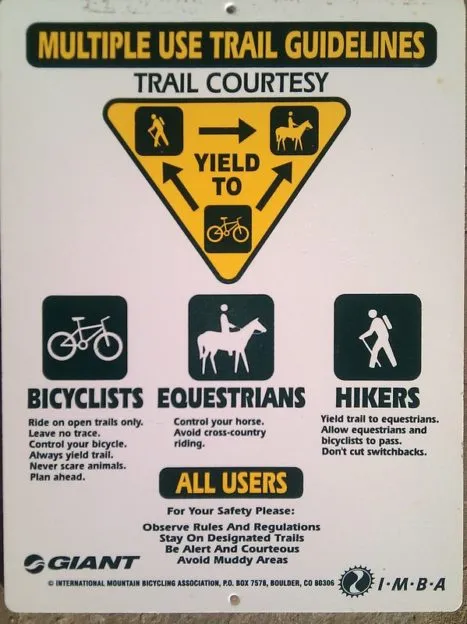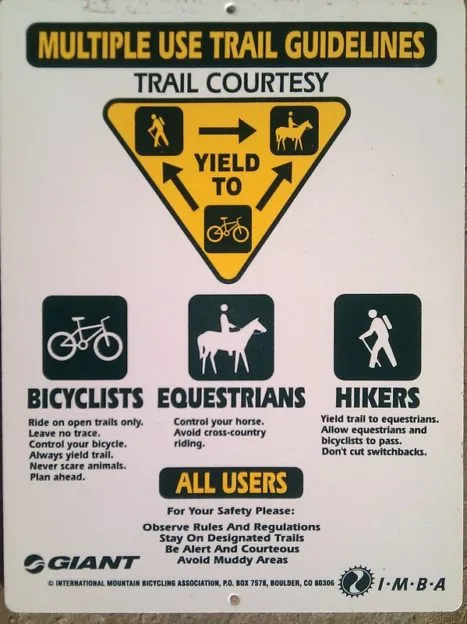
The Complete Guide to Trail Courtesy Tips: Essential Etiquette for Every Outdoor Enthusiast
Discover the essential trail courtesy tips that every hiker, biker, and outdoor enthusiast should know. From my years of exploring trails across the country, I've learned that proper etiquette transforms outdoor experiences for everyone. This comprehensive guide covers everything from right-of-way rules to wildlife encounters, ensuring your adventures on Nature Guests trails are both respectful and memorable.
Understanding the Basics of Trail Courtesy
During my first hiking experience in Yellowstone National Park, I quickly learned that trail courtesy tips aren't just suggestions—they're essential guidelines that ensure everyone's safety and enjoyment. I remember encountering a family of bison on the trail, and watching experienced hikers demonstrate proper wildlife protocol taught me invaluable lessons that I still follow today.
.webp)
The foundation of trail courtesy lies in the golden rule: treat others as you would want to be treated. This principle extends beyond human interactions to encompass our relationship with nature itself. When I guide newcomers on their first hiking adventures, I always emphasize that trail courtesy tips begin with mindset—approaching the outdoors with respect, humility, and awareness.
Essential preparation forms the cornerstone of courteous trail behavior. Before heading out, I always recommend checking trail conditions, weather forecasts, and specific regulations for your chosen destination. Understanding how to read trail signs properly ensures you're following all posted guidelines and restrictions. This preparation demonstrates respect for land managers, fellow hikers, and the environment.
💡 Pro Tip: Always carry essential safety equipment, including a first aid kit, extra water, and communication device. Being prepared prevents you from becoming a burden to other hikers or rescue services.
📚 Get the Complete Hiking Guide on Amazon
Mastering Right-of-Way Rules
Understanding right-of-way protocols represents one of the most crucial trail courtesy tips every outdoor enthusiast must master. During my hiking adventures across the Appalachian Trail, I've witnessed countless situations where proper right-of-way knowledge prevented conflicts and potential accidents. The basic hierarchy places uphill hikers at the top, followed by hikers, then mountain bikers, with equestrians having universal right-of-way.
Uphill hikers deserve the right-of-way because they're working harder and have more limited visibility of the trail ahead. I always teach newcomers to step aside gracefully when encountering ascending hikers, positioning themselves on the downhill side when safely possible. This courtesy acknowledges the extra effort required for uphill movement and helps maintain the uphill hiker's momentum and rhythm.
Mountain bikers should yield to all other trail users, but I've learned that flexibility often trumps rigid rules. On technical terrain where stopping might be dangerous for cyclists, I sometimes step aside even when I have the right-of-way. Understanding reading hiking trail maps helps identify multi-use sections where these interactions are more likely to occur.

Equestrian encounters require special consideration in our trail courtesy tips guidelines. Horses can be unpredictable around strangers, so I always stop completely, make myself visible, and speak calmly to announce my presence. Following the rider's instructions is paramount—they know their horse's temperament best. I've found that asking "What would you like me to do?" demonstrates respect and ensures everyone's safety.
🔔 Essential Trail Safety Bell - Order Now
Effective Trail Communication
Clear, friendly communication forms the heart of effective trail courtesy tips. Throughout my years exploring trails from the Pacific Northwest to the Southeast, I've discovered that a simple greeting can transform a tense encounter into a pleasant interaction. The key lies in timing, tone, and technique—announcing your presence early enough to avoid startling others while maintaining a friendly, non-threatening demeanor.
When approaching other trail users from behind, I've learned to call out cheerfully from a reasonable distance: "Good morning! Hiker coming up behind you on your left." This gives people time to process your presence and decide how to respond. Some prefer to step aside immediately, while others might need a moment to find a suitable spot. Patience is essential—rushing or pressuring others contradicts the spirit of courtesy.
Non-Verbal Communication Techniques
Body language speaks volumes on the trail. I always make eye contact when possible, smile genuinely, and use open gestures. When yielding right-of-way, I step far enough off the trail to make others comfortable while avoiding vegetation damage. A friendly wave or nod acknowledges fellow hikers even when verbal communication isn't necessary. These small gestures contribute to the positive trail atmosphere that makes outdoor adventures memorable.
Sound management represents another crucial aspect of trail courtesy tips. Natural sounds—birdsong, wind through trees, flowing water—form the soundtrack of outdoor experiences. I always keep conversations at moderate volumes and avoid playing music without headphones. Electronic devices should remain on silent mode; the trail offers a precious opportunity to disconnect from digital distractions and reconnect with nature's rhythms.
🎯 Communication Best Practice: When using compass hiking techniques, explain your navigation needs to companions clearly to avoid confusion on the trail.
Group management requires special attention to communication protocols. Large groups should spread out to avoid monopolizing narrow trails, with experienced members positioned at both front and rear. I designate communication leaders who relay important information throughout the group. When encountering other trail users, the lead person should announce the group size: "Good afternoon! We have eight hikers coming through." This helps others prepare for the extended interaction.
🎒 Professional Hiking Backpack - Check Price
Environmental Respect and Leave No Trace
Environmental stewardship represents the most enduring aspect of trail courtesy tips. During my decade of guiding nature walks, I've witnessed firsthand how individual actions accumulate into significant environmental impact. Staying on designated trails prevents erosion, protects fragile ecosystems, and preserves the natural experience for future visitors. Even seemingly minor deviations can create lasting damage in sensitive environments.
Wildlife encounters demand respectful distance and patient observation. I maintain a minimum of 25 yards from most wildlife, increasing to 100 yards for bears and large predators. Never attempt to feed wild animals—this dangerous practice alters their natural behavior and can lead to aggressive encounters with future hikers. Photography should be conducted from appropriate distances using telephoto lenses rather than approaching animals closely.
Waste Management and Trail Maintenance
Proper waste management extends beyond the basic "pack it in, pack it out" principle. I carry extra bags to collect litter left by less conscientious visitors, viewing trail cleanup as community service. Organic waste, including apple cores and banana peels, should be packed out rather than discarded—these items can take months to decompose and attract wildlife to trail areas where they don't naturally belong.
Understanding when to avoid trails forms another essential component of trail courtesy tips. Muddy conditions make trails vulnerable to erosion and widening. I postpone hikes during wet weather or choose established, well-drained paths instead. This patience protects trail infrastructure and demonstrates respect for the volunteer efforts that maintain our outdoor recreational opportunities.
Trail conditions affect navigation decisions significantly. Knowing the difference between GPS vs map navigation helps hikers choose appropriate tools for different conditions while staying on designated routes. GPS devices can lose signal in dense forest canopy, making traditional map and compass skills invaluable for maintaining proper trail adherence.
⚠️ Important: Never create shortcuts or social trails. These unauthorized paths cause erosion, habitat fragmentation, and maintenance problems for land managers.
Multi-Use Trail Sharing Strategies
Multi-use trail management requires advanced trail courtesy tips that accommodate diverse recreational activities. During my experience managing trail systems in Colorado, I've learned that successful sharing depends on mutual understanding, clear communication, and flexible application of etiquette principles. Different user groups have varying speeds, sight lines, and maneuverability, requiring adaptive courtesy approaches.
Mountain bikers face unique challenges on shared trails. Their higher speeds and limited maneuverability in technical terrain require special consideration from other users. I've developed relationships with local cycling groups to understand their perspectives and needs. When encountering cyclists on narrow trails, I look for safe pull-out spots early, making my intentions clear through hand signals and verbal communication.
Seasonal Considerations and Peak Usage Management
Peak season trail usage intensifies the importance of courtesy protocols. Weekend mornings on popular trails can resemble highway traffic, requiring patience and advanced planning. I often recommend off-peak timing to newcomers, explaining how early morning or weekday hikes provide better opportunities to practice trail courtesy tips in less crowded conditions.
Weather conditions dramatically affect multi-use trail dynamics. Wet conditions make mountain bike traffic particularly damaging to trail surfaces, while icy conditions create hazards for all users. I monitor local conditions and adjust my hiking plans accordingly, sometimes choosing different activities when trail conditions make hiking inappropriate. This flexibility demonstrates environmental responsibility and safety awareness.
Technology integration requires careful consideration in modern trail courtesy. While trail courtesy tips traditionally focused on human interactions, modern hikers must also consider the impact of GPS devices, smartphones, and fitness trackers. These tools should enhance rather than detract from the natural experience, used discreetly without disrupting the peaceful trail atmosphere.
🏕️ Complete Trail Safety Kit - Shop Now
🌟 Expert Insight: The best trail courtesy comes from understanding that everyone shares the same goal—enjoying nature safely and responsibly. Flexibility and kindness solve most trail conflicts before they escalate.
Group dynamics on multi-use trails require special management strategies. Large hiking groups should designate sweep riders and lead scouts when sharing trails with cyclists. I recommend maintaining single-file formation on narrow sections and establishing clear communication protocols for encounters with other user groups. These practices minimize confusion and demonstrate organized, responsible group behavior that other trail users appreciate and respect.
Conclusion
Mastering trail courtesy tips transforms outdoor adventures from potentially stressful encounters into enriching community experiences. Throughout my years of hiking, guiding, and trail advocacy, I've witnessed how proper etiquette creates positive ripple effects that extend far beyond individual interactions. When hikers demonstrate respect for each other and the environment, they inspire others to do the same, building a culture of responsibility that preserves our natural spaces for future generations.
The principles covered in this comprehensive guide—from right-of-way protocols to environmental stewardship—form an interconnected system of mutual respect and safety. These trail courtesy tips aren't merely suggestions; they're essential skills that every outdoor enthusiast should develop and practice consistently. As trail usage continues to increase, individual responsibility becomes increasingly important for maintaining the quality and accessibility of our beloved outdoor spaces.
Remember that courtesy is contagious. Every positive interaction on the trail contributes to a welcoming atmosphere that encourages more people to explore and appreciate nature. By implementing these trail courtesy tips consistently, you become an ambassador for responsible outdoor recreation, helping to ensure that future generations can enjoy the same incredible experiences that draw us to the trails today.
I encourage you to share these principles with fellow outdoor enthusiasts and continue learning about respectful trail practices. The outdoor community thrives when everyone contributes to positive trail experiences through knowledge, preparation, and genuine consideration for others. Take these trail courtesy tips with you on your next adventure, and help build the kind of trail community we all want to be part of.
Ready to Practice Trail Courtesy?
Start your next adventure with the right mindset and equipment. These trail courtesy tips will enhance every outdoor experience.
🛒 Shop Trail Essentials
